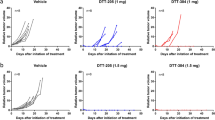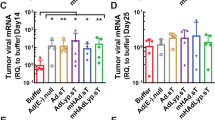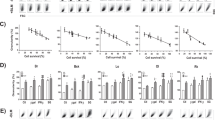Abstract
The bacterial cytosine deaminase (CD) gene converts the non-toxic prodrug 5-fluorocytosine (5-FC) into 5-fluorouracil. We have previously shown, in a rat liver metastasis model from colon carcinoma, that intratumoral injection of a CD-expressing plasmid into the animals followed by 5-FC treatment results in the regression of the treated tumor as well as distant uninjected tumors. The aim of this study was to further analyze the mechanisms associated with tumor regression induced upon application of suicide CD/5-FC strategy. Tumor regression was associated with an increased apoptosis, the recruitment of natural killer cells, CD4- and CD8 T lymphocytes within the tumors and an increased expression of several cytokines/chemokines mRNAs. These data indicate that the CD/5-FC suicide strategy is associated with the triggering of cellular and molecular events leading to an efficient antitumor immune response involving both innate and acquired immunity.
This is a preview of subscription content, access via your institution
Access options
Subscribe to this journal
Receive 12 print issues and online access
$259.00 per year
only $21.58 per issue
Buy this article
- Purchase on Springer Link
- Instant access to full article PDF
Prices may be subject to local taxes which are calculated during checkout





Similar content being viewed by others
Abbreviations
- CD:
-
cytosine deaminase
- Chol:
-
cholesterol
- DOTAP:
-
1,2-dioleoyl-3-(trimethylammonium) propane
- 5-FC:
-
5-fluorocytosine
- 5-FU:
-
5-fluorouracil
- Lt-β:
-
lymphotactin-β
- MCP-1:
-
monocyte chemoattractant protein-1
- NK:
-
natural killer
- RPA:
-
RNase protection assay
- TUNEL:
-
terminal deoxynucleotidyltransferase-mediated deoxyuridine triphosphate nick end labeling
References
Consensus conference: Prevention Screening and Management of the Colonic Cancers. Paris, France, January 29–30, 1998. Proceedings. Gastroenterol Clin Biol 1998; 22: S1–S295.
Jaeck D, Bachellier P . Colonic cancers with visceral metastasis (synchronous or metachronous): which surgical treatment to offer? Gastroenterol Clin Biol 1998; 22: S168–S176.
Goyle S, Maraveyas A . Chemotherapy for colorectal cancer. Dig Surg 2005; 22: 401–414.
Lal S, Lauer UM, Niethammer D, Beck JF, Schlegel PG . Suicide genes: past, present and future perspectives. Immunol Today 2000; 21: 48–54.
Huber BE, Austin EA, Richards CA, Davis ST, Good SS . Metabolism of 5-fluorocytosine to 5-fluorouracil in human colorectal tumor cells transduced with the cytosine deaminase gene: significant antitumor effects when only a small percentage of tumor cells express cytosine deaminase. Proc Natl Acad Sci USA 1994; 91: 8302–8306.
Freeman SM, Abboud CN, Whartenby KA, Packman CH, Koeplin DS, Moolten FL et al. The ‘bystander effect’: tumor regression when a fraction of the tumor mass is genetically modified. Cancer Res 1993; 53: 5274–5283.
Packman CH, Koeplin DS, Moolten FL, Consalvo M, Mullen CA, Modesti A et al. 5-Fluorocytosine-induced eradication of murine adenocarcinomas engineered to express the cytosine deaminase suicide gene requires host immune competence and leaves an efficient memory. J Immunol 1995; 154: 5302–5312.
Dilber MS, Abedi MR, Bjorkstrand B, Christensson B, Gahrton G, Xanthopoulos KG et al. Suicide gene therapy for plasma cell tumors. Blood 1996; 88: 2192–2200.
Bi W, Kim YG, Feliciano ES, Pavelic L, Wilson KM, Pavelic ZP et al. An HSVtk-mediated local and distant antitumor bystander effect in tumors of head and neck origin in athymic mice. Cancer Gene Ther 1997; 4: 246–252.
Kianmanesh AR, Perrin H, Panis Y, Fabre M, Nagy HJ, Houssin D et al. A ‘distant’ bystander effect of suicide gene therapy: regression of nontransduced tumors together with a distant transduced tumor. Hum Gene Ther 1997; 8: 1807–1814.
Hall SJ, Sanford MA, Atkinson G, Chen SH . Induction of potent antitumor natural killer cell activity by herpes simplex virus-thymidine kinase and ganciclovir therapy in an orthotopic mouse model of prostate cancer. Cancer Res 1998; 58: 3221–3225.
Pierrefite-Carle V, Baque P, Gavelli A, Mala M, Chazal M, Gugenheim J et al. Cytosine deaminase/5-fluorocytosine-based vaccination against liver tumors: evidence of distant bystander effect. J Natl Cancer Inst 1999; 91: 2014–2019.
Faneca H, Cabrita AS, Simoes S, Pedroso de Lima MC . Evaluation of the antitumoral effect mediated by IL-12 and HSV-tk genes when delivered by a novel lipid-based system. Biochim Biophys Acta 2007; 5: 1093–1102.
da Cruz MT, Cardoso AL, de Almeida LP, Simoes S, de Lima MC . Tf-lipoplex-mediated NGF gene transfer to the CNS: neuronal protection and recovery in an excitotoxic model of brain injury. Gene Therapy 2005; 12: 1242–1252.
Wiley website: http://www.wiley.co.uk/genemed/clinical/2006.
Herweijer H, Wolff JA . Progress and prospects: naked DNA gene transfer and therapy. Gene Therapy 2003; 10: 453–458.
Gao X, Huang L . Cationic liposome-mediated gene transfer. Gene Therapy 1995; 2: 710–722.
Pedroso de Lima MC, Neves S, Filipe A, Duzgunes N, Simões S . Cationic liposomes for gene delivery: from biophysics to biological applications. Curr Med Chem 2003; 10: 1221–1231.
Pope IM, Poston GJ, Kinsella AR . The role of the bystander effect in suicide gene therapy. Eur J Cancer 1997; 33: 1005–1016.
Mullen CA, Kilstrup M, Blaese RM . Transfer of the bacterial gene for cytosine deaminase to mammalian cells confers lethal sensitivity to 5-fluorocytosine: a negative selection system. Proc Natl Acad Sci USA 1992; 89: 33–37.
Baque P, Pierrefite-Carle V, Gavelli A, Brossette N, Benchimol D, Bourgeon A et al. Naked DNA injection for liver metastases treatment in rats. Hepatology 2002; 35: 1144–1152.
Martin F, Caignard A, Jeannin JF, Leclerc A, Martin M . Selection by trypsin of two sublines of rat colon cancer cells forming progressive or regressive tumors. Int J Cancer 1983; 32: 623–627.
Simoes S, Slepushkin V, Gaspar R, de Lima MC, Duzgunes N . Gene delivery by negatively charged ternary complexes of DNA, cationic liposomes and transferrin or fusigenic peptides. Gene Therapy 1998; 5: 955–964.
Auerbach R, Morissey LW, Sidky YA . Regional differences in the incidence and growth of mouse tumors following intradermal or subcutaneous inoculation. Cancer Res 1978; 38: 1739–1744.
Fischer U, Steffens S, Frank S, Rainov NG, Schulze-Osthoff K, Kramm CM . Mechanisms of thymidine kinase/ganciclovir and cytosine deaminase/ 5-fluorocytosine suicide gene therapy-induced cell death in glioma cells. Oncogene 2005; 24: 1231–1243.
Zhang SN, Yuan SZ, Zhu ZH, Wen ZF, Huang ZQ, Zeng ZY . Apoptosis induced by 5-flucytosine in human pancreatic cancer cells genetically modified to express cytosine deaminase. Acta Pharmacol Sin 2000; 21: 655–659.
Bentires-Alj M, Hellin AC, Lechanteur C, Princen F, Lopez M, Fillet G et al. Cytosine deaminase suicide gene therapy for peritoneal carcinomatosis. Cancer Gene Ther 2000; 7: 20–26.
Hedrick JA, Zlotnik A . Lymphotactin. Clin Immunol Immunopathol 1998; 87: 218–222.
Ju DW, Tao Q, Cheng DS, Zhang W, Zhang M, Hamada H et al. Adenovirus-mediated lymphotactin gene transfer improves therapeutic efficacy of cytosine deaminase suicide gene therapy in established murine colon carcinoma. Gene Therapy 2000; 7: 329–338.
Allavena P, Bianchi G, Zhou D, van Damme J, Jilek P, Sozzani S et al. Induction of natural killer cell migration by monocyte chemotactic protein-1, -2 and -3. Eur J Immunol 1994; 24: 3233–3236.
Taub DD, Sayers TJ, Carter CR, Ortaldo JR . Alpha and beta chemokines induce NK cell migration and enhance NK-mediated cytolysis. J Immunol 1995; 155: 3877–3888.
Tsuchiyama T, Kaneko S, Nakamoto Y, Sakai Y, Honda M, Mukaida N et al. Enhanced antitumor effects of a bicistronic adenovirus vector expressing both herpes simplex virus thymidine kinase and monocyte chemoattractant protein-1 against hepatocellular carcinoma. Cancer Gene Ther 2003; 10: 260–269.
Bierie B, Moses HL . Tumour microenvironment: TGFbeta: the molecular Jekyll and Hyde of cancer. Nat Rev Cancer 2006; 6: 506–520.
Munoz NM, Upton M, Rojas A, Washington MK, Lin L, Chytil A et al. Transforming growth factor beta receptor type II inactivation induces the malignant transformation of intestinal neoplasms initiated by Apc mutation. Cancer Res 2006; 66: 9837–9844.
Rumsaeng V, Vliagoftis H, Oh CK, Metcalfe DD . Lymphotactin gene expression in mast cells following Fc(epsilon) receptor I aggregation: modulation by TGF-beta, IL-4, dexamethasone, and cyclosporin A. J Immunol 1997; 158: 1353–1360.
Arend WP . The balance between IL-1 and IL-1Ra in disease. Cytokine Growth Factor Rev 2002; 13: 323–340.
Apte RN, Krelin Y, Song X, Dotan S, Recih E, Elkabets M et al. Effects of micro-environment- and malignant cell-derived interleukin-1 in carcinogenesis, tumour invasiveness and tumour–host interactions. Eur J Cancer 2006; 42: 751–759.
Konishi N, Miki C, Yoshida T, Tanaka K, Toiyama Y, Kusunoki M . Interleukin-1 receptor antagonist inhibits the expression of vascular endothelial growth factor in colorectal carcinoma. Oncology 2005; 68: 138–145.
Elaraj DM, Weinreich DM, Varghese S, Puhlmann M, Hewitt SM, Carroll NM et al. The role of interleukin 1 in growth and metastasis of human cancer xenografts. Clin Cancer Res 2006; 12: 1088–1096.
Okamura H, Tsutsi H, Komatsu T, Yutsudo M, Hakura A, Tanimoto T et al. Cloning of a new cytokine that induces IFN-gamma production by T cells. Nature 1995; 378: 88–91.
Ghiringhelli F, Larmonier N, Schmitt E, Parcellier A, Cathelin D, Garrido C et al. CD4+CD25+ regulatory T cells suppress tumor immunity but are sensitive to cyclophosphamide which allows immunotherapy of established tumors to be curative. Eur J Immunol 2004; 34: 336–344.
Acknowledgements
We thank Dr Pascal Staccini (Département Informatique Médicale, Faculté de Médecine, Nice) for statistical analysis of the results. We also thank Agnès Loubat, Vincent Balaya, Olivier Camuzard and Vincent Saury for expert technical assistance. We would like to dedicate this work to Bernard Rossi, Head of the Laboratory, who deceased in May 2006. This work was supported by the Institut National de la Santé et de la Recherche Médicale, Fondation de l'Avenir, France Cancer and Association pour la Recherche sur le Cancer and by the Portuguese Foundation for Science and Technology (Grants SFRH/BD/8711/2002 and POCTI/CVT/44854/2002).
Author information
Authors and Affiliations
Corresponding author
Rights and permissions
About this article
Cite this article
Bertin, S., Neves, S., Gavelli, A. et al. Cellular and molecular events associated with the antitumor response induced by the cytosine deaminase/5-fluorocytosine suicide gene therapy system in a rat liver metastasis model. Cancer Gene Ther 14, 858–866 (2007). https://doi.org/10.1038/sj.cgt.7701075
Received:
Revised:
Accepted:
Published:
Issue Date:
DOI: https://doi.org/10.1038/sj.cgt.7701075



